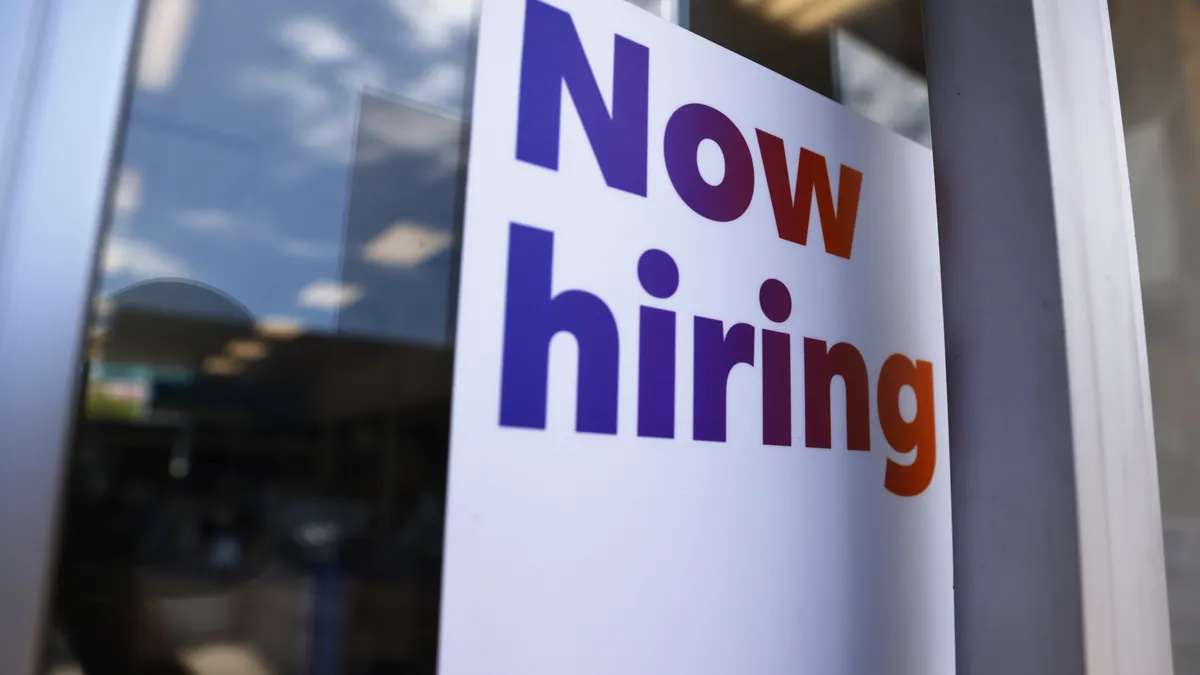Dive Brief:
- Employers hired 253,000 workers in April — the biggest gain since January — and wage growth sped up despite aggressive monetary tightening and a pullback in bank credit caused by stress in the banking system since mid-March.
- The unemployment rate dipped to 3.4% from 3.5% in March and average hourly earnings rose 4.4% in the 12 months through April compared with a 4.2% gain the prior month, the Labor Department said Friday.
- “The jobs report seems to counter-indicate the narrative in the general media that the economy is slowing and that a recession is approaching,” Kate Duchene, CEO of global consultancy RGP, said in an interview. “There is just so much disruption happening in business today,” she said, noting rapid advances in technology. “With change comes opportunity.”
Dive Insight:
Federal Reserve Chair Jerome Powell said Wednesday that labor supply and demand have moved into “better balance,” noting an increase in the labor participation rate, slowing wage growth and a decline in job vacancies.
“We do see some softening” in recent months, Powell said, while noting that the labor market is “still extraordinarily tight.”
Powell spoke minutes after the central bank raised the main interest rate by a quarter percentage point in its tenth consecutive hike since March 2022. Policymakers suggested that in the future they may pause their most aggressive monetary policy in four decades depending on incoming data on inflation and other factors.
Companies in the service sector in April continued to lead employment gains, adding 197,000 jobs, the Labor Department said. Within that category, hiring was robust in professional and business services, private education, health services, and leisure and hospitality.
With unemployment falling to the lowest level since 1969, “job growth remains far too strong to alleviate the imbalances in the labor market,” Fitch Ratings Chief Economist Brian Coulton said.
“It is clear that wage pressures on inflation are proving persistent,” Coulton said in an email, noting recent increases in compensation and unit labor costs.
Wages and salaries among private sector workers increased in March at a 12-month, 5.1% pace, a higher-than-forecast rate that underscores the risk of a mutually reinforcing upward spiral of wages and prices.
“This jobs report will not convince the Fed that they are on top of inflation,” Coulton said.
The central bank has failed to achieve a sustained decline in inflation toward its 2% target even after pursuing the most aggressive monetary tightening in four decades. Policymakers have raised the federal funds rate since March 2022 from near zero to a range between 5% and 5.25%.
The Fed’s preferred inflation measure — the core personal consumption expenditures price index excluding food and energy — rose 4.9% during the first quarter compared with 4.4% during the fourth quarter of 2022.
“Inflation pressures continue to run high and the process of getting inflation back down to 2% has a long way to go,” Powell told reporters Wednesday. Based on its current forecast, the Fed is unlikely to cut the main interest rate this year, he said.
The Fed, as part of its fight against inflation, has made progress in curbing economic growth.
Manufacturing has slowed in recent months along with consumer spending, which generates about 70% of gross domestic product. After a 2% gain in January, household spending rose 0.1% in February and was flat in March, according to the Commerce Department.
GDP on an annual basis slowed to 1.1% during the first quarter from 2.6% during the fourth quarter, and Fed economists in March forecast a mild recession this year, reversing their December forecast for sustained growth.
The labor market by some measures has loosened to a degree during the past year. Forty-five percent of small businesses reported difficulty filling job openings in April compared with a record 51% in May 2022, the National Federation of Independent Business found in a survey released Thursday.
Moreover, the 253,000 gain in nonfarm payroll employment during April falls short of the average monthly gain of 290,000 during the prior six months, the Labor Department said.
CFOs and their C-suite colleagues should not jump to conclusions based on just one month of employment data, according to Peter Cappelli, director of the Center for Human Resources at the University of Pennsylvania’s Wharton School.
“The labor market adjusts with a lag,” Cappelli said in an interview, adding “the problems about credit that people are talking about because of bank failures — none of that is observable in the current labor market because those things just happened.”
Moreover, “there has been a tendency to revise these numbers down,” he said.
Indeed, the Labor Department on Friday marked down its earlier number for growth in nonfarm payrolls for February to 248,000 from 326,000, and for March to 165,000 from 236,000.












